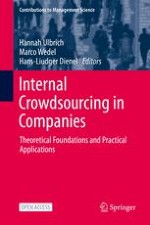This open access book examines the implications of internal crowdsourcing (IC) in companies. Presenting an employee-oriented, cross-sector reference model for good IC practice, it discusses the core theoretical foundations, and offers guidelines for process-management and blueprints for the implementation of IC. Furthermore, it examines solutions for employee training and competence development based on crowdsourcing. As such, the book will appeal to scholars of management science, work studies, organizational and participation research and to readers interested in inclusive approaches for cooperative change management and the IT implications for IC platforms.
